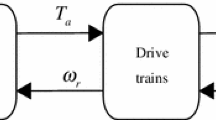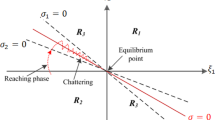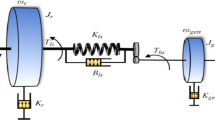Abstract
The wind energy conversion system (WECS) is a system which allows the conversion of wind-generated kinetic energy to electrical energy. One of the currently used systems to generate electrical energy is the permanent magnet synchronous generator. The proposed control method in this paper is Takagi–Sugeno (T–S) fuzzy model-based integral sliding mode control (ISMC). The ISMC method performs robustness to external disturbances and noises. The one important issue of the WECS is the variable wind speed which varies drastically over short periods of time. The solution to the problem of the wind speed estimation is the disturbance observer application which was also used to estimate the wind speed. The use of T–S fuzzy model is justified by the robustness to unmatched disturbances. The novelty of the proposed combination of control techniques is the solution to problems of nonlinearity, estimation of the aerodynamic torque and the chattering natural for sliding mode control. The simulation was conducted in MATLAB/Simulink software. The results are provided in the result-related section.











Similar content being viewed by others
References
Jha AR (2011) Wind turbine technology. CRC Press, Boca Raton
Kolar JW, Friedli T, Krismer F et al (2011) Conceptualization and multi-objective optimization of the electric system of an airborne wind turbine. In: IEEE international symposium on industrial electronics
Gawande SP, Porate KB (2009) Review of parallel operation of synchronous generator and induction generator for stability. In: Second international conference on emerging trends in engineering and technology
Wu B, Lang Y, Zargari N, Kouro S (2011) Power conversion and control of wind energy systems. Wiley, Hoboken
Kurronen P, Haavisto M, Pyrhonen J (2010) Challenges in applying permanent magnet (PM) technology to wind power generators. In: European wind energy conference
Rodrigues J, Cortes P (2012) Predictive control of power converters electrical drives. Wiley, Hoboken
Shen YX, He QN, Pan TL et al (2013) T–S fuzzy robust fault-tolerant control strategy for wind energy conversion system. In: 8th conference on industrial electronics and applications
Kaewpraek N, Assawinchaichote W (2013) Control of PMSG wind energy conversion system with T–S fuzzy state-feedback controller. Appl Mech Mater 446–447(2014):728–732
Ounnas D, Ramdani M, Chenikher S et al (2016) Optimal reference model based fuzzy tracking control for wind energy conversion system. Int J Renew Energy Res 6(3):1129–1136
Muhando BE, Senjyu T, Urasaki N (2007) Gain scheduling control of variable speed WTG under widely varying turbulence loading. Renew Energy 32(14):2407–2423
Sumbekov S, Do TD (2018) Sliding mode controller with DOBC and MTPA Trajectroty for surface-mounted PMSM. In: 4th international conference on green technology and sustainable development, Ho Chi Minh City, Vietnam
Busca C, Stan AI, Stanciu T et al (2010) Control of permanent magnet synchronous generator for large wind turbines. In: International symposium on industrial electronics
Rahim AHMA, Khan MH (2013) An adaptive optimum SMES controller for a PMSG wind generation system. In: IEEE power and energy society general meeting
Mozayan SM, Saad M, Vahedi H et al (2016) Sliding mode control of PMSG wind turbine based on enhanced exponential reaching law. IEEE Trans on Ind Electron 63(10):6148–6159
Yao B, Tomizuka M (1997) Adaptive robust control of SISO nonlinear systems in a semi-strict feedback form. Automatica 33(5):893–900
Rubio JJ (2018) Robust feedback linearization for nonlinear processes control. ISA Trans 74:155–164
Rubio JJ, Pieper J, Meda-Campana JA et al (2018) Modelling and regulation of two mechanical systems. IET Sci Meas Technol 12(5):657–665
Sun Y, Qiang H, Mei X et al (2018) Modified repetitive learning control with unidirectional control input for uncertain nonlinear systems. Neural Comput Appl 30(6):2003–2012
Rubio JJ (2016) Structure control for the disturbance rejection in two electromechanical processes. J Franklin Inst 353(4):3610–3631
Lin CH (2013) Novel modified elman neural network control for PMSG system based on wind turbine emulator. Math Prob Eng 2013:1–15
Nagrath IJ, Gopal M (2008) Control systems engineering, 5th edn. Anshan, Tunbridge Wells
Lahfaoui B, Zouggar S, Mohammed B et al (2017) Real time study of PnO MPPT control for small wind PMSG turbine systems using arduino microcontroller. Energy Procedia 111:1000–1009
Abdullah MA, Yatim AHM, Tan CW et al (2012) A review of maximum power point tracking algorithms for wind energy systems. Renew Sustain Energy Rev 16(5):3220–3227
Ayadi M, Naifar O, Derbel N (2017) Sensorless control with an adaptive sliding mode observer for wind PMSG systems. In: 14th international multi-conference on systems, signals and devices
Orlando NA, Liserre M, Mastromauro RA et al (2013) A survey of control issues in PMSG-based small wind-turbine systems. IEEE Trans Ind Inform 9(3):1211–1221
Le AV, Do TD (2018) High-order observers-based LQ control scheme for wind speed and uncertainties estimation in WECSs. Optim Control Appl Methods 39(5):1818–1832
Gauterin E, Kammerer P, Kühn M et al (2016) Effective wind speed estimation: comparison between Kalman filter and Takagi–Sugeno observer techniques. ISA Trans 62:60–72
Hodzic M, Tai LC (2016) Grey predictor reference model for assisting particle swarm optimization for wind turbine control. Renew Energy 86:251–256
Song D, Yang J, Dong M, Joo YH (2017) Kalman filter-based wind speed estimation for wind turbine control. Int J Control Autom Syst 15(3):1089–1096
Kaur A, Kaur A (2012) Comparison of Mamdani-type and Sugeno-type fuzzy inference systems for air conditioning system. Int J Soft Comput Eng 2(2):323–325
Do TD, Kwak S, Choi HH et al (2014) Suboptimal control scheme design for interior permanent-magnet synchronous motors: an SDRE-based approach. IEEE Trans on Power Electron 29(6):3021
Vu NTT, Yu DY, Choi HH et al (2013) T–S fuzzy-model-based sliding-mode control for surface-mounted permanent-magnet synchronous motors considering uncertainties. IEEE Trans Ind Electron 60(10):4281–4291
Choi HH, Vu NTT, Jung JW (2012) Design and implementation of a Takagi–Sugeno fuzzy speed regulator for a permanent magnet synchronous motor. IEEE Trans Ind Electron 59(8):3069–3077
Fridman L, Poznyak AS, Bejarano FJ (2014) Robust ouput LQ optimal control via integral sliding modes. Springer, Berlin
Riedinger P, Kratz F, Iung C et al (2002) Linear quadratic optimization for hybrid systems. In: 38th conference on decision and control, Phoenix, Arizona
Martinez F, Herrero LH, de Pablo S (2014) Open loop wind turbine emulator. Renew Energy 63(2014):212–221
Popiolek J (1989) Some properties of functions modul and signum. Formal Math 1(2):263–264
Kim EK, Mwasilu F, Choi HH et al (2015) An observer-based optimal voltage control scheme for three-phase UPS systems. IEEE Trans Ind Electron 62(4):2073–2081
Li S, Yang J, Chen W, Chen X (2014) Disturbance observer based control. Taylor and Francis Group, Boca Raton
Radke A, Gao Z (2006) A survey of state and disturbance observers for practitioners. In: American control conference. Minneapolis, USA
Valenciaga F, Puleston PF (2008) High-order sliding control for a wind energy conversion system based on a permanent magnet synchronous generator. IEEE Trans Energy Conv 23:860–867
Acknowledgements
The work was sponsored by the Ministry of Education and Science of the Republic of Kazakhstan, Grant/Award Numbers: BR0523652 and BR05236524.
Author information
Authors and Affiliations
Corresponding author
Additional information
Publisher's Note
Springer Nature remains neutral with regard to jurisdictional claims in published maps and institutional affiliations.
Rights and permissions
About this article
Cite this article
Sumbekov, S., Phuc, B.D.H. & Do, T.D. Takagi–Sugeno fuzzy-based integral sliding mode control for wind energy conversion systems with disturbance observer. Electr Eng 102, 1141–1151 (2020). https://doi.org/10.1007/s00202-020-00939-2
Received:
Accepted:
Published:
Issue Date:
DOI: https://doi.org/10.1007/s00202-020-00939-2




